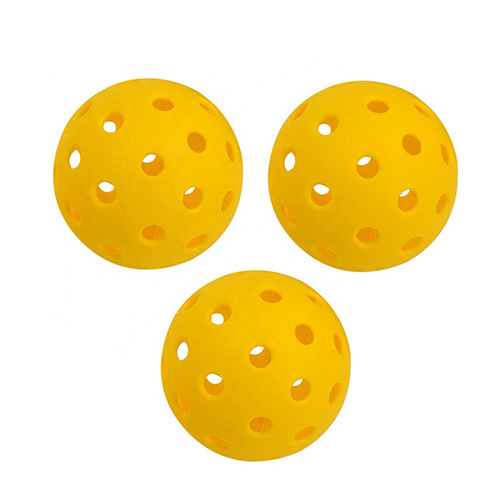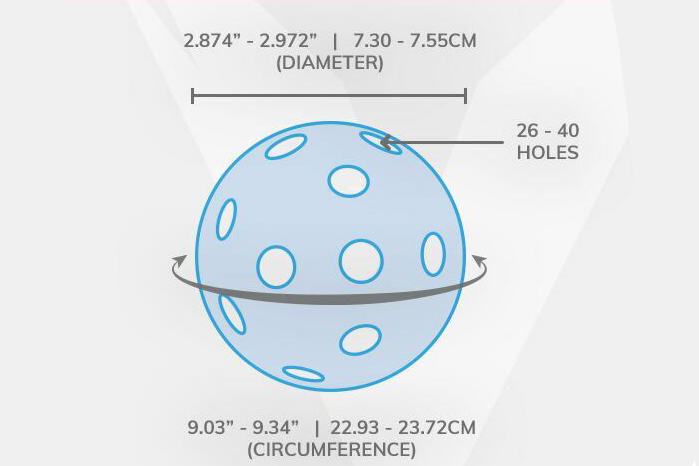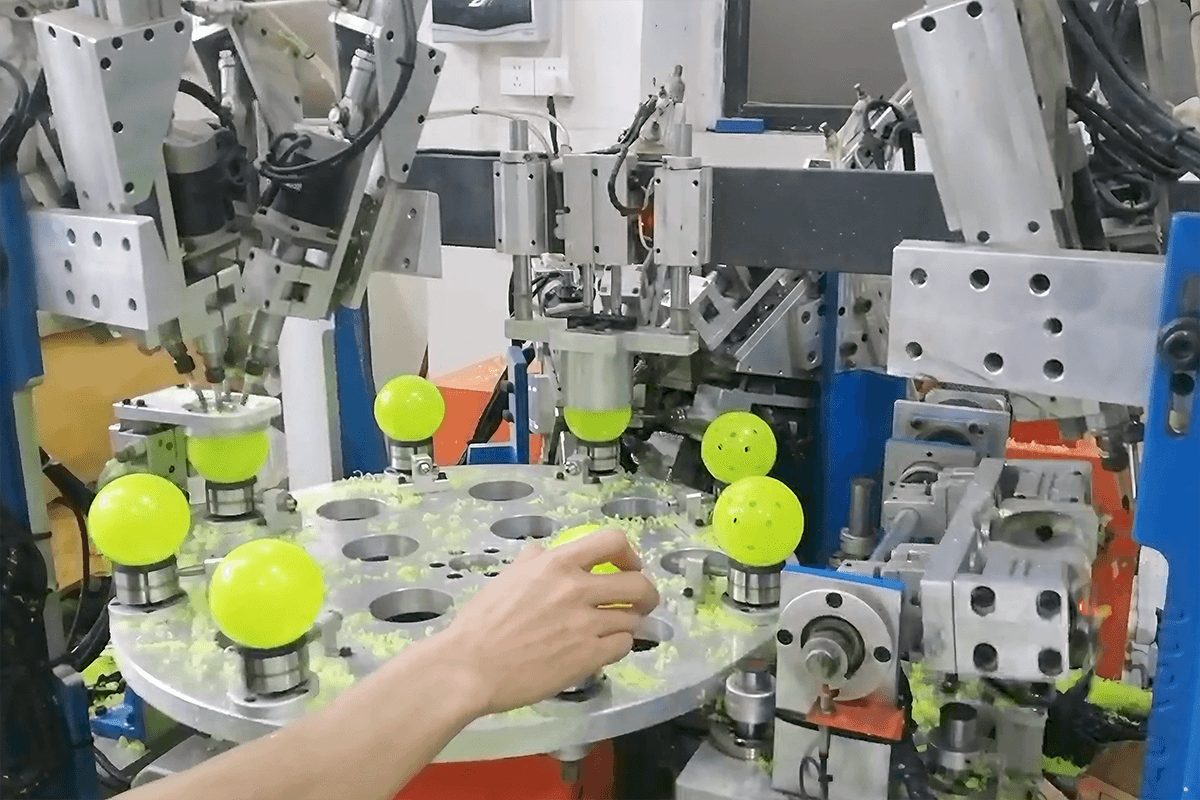Have you ever been in the middle of a game and wondered what makes that pickleball bounce just right? Let’s dive into the fascinating world of pickleball materials!
Pickleballs are made from plastic polymers, mainly polyethylene or polypropylene. Indoor balls are softer with fewer holes, while outdoor balls use harder plastic with more holes to withstand wind and rough surfaces. These materials influence bounce, control, and durability.
Now that you’ve got the basics down, let’s dig deeper into how these materials and manufacturing processes can elevate your game experience!
Outdoor pickleballs have more holes than indoor ones.True
Outdoor pickleballs have more holes to minimize wind impact.
How Does the Manufacturing Process Affect Pickleball Performance?
Ever wondered how the way a pickleball is made can change your game? Let’s find out.
The manufacturing process of pickleballs, whether through injection molding or rotational molding, significantly impacts their performance. Injection-molded balls have seams and offer higher bounce, while rotational-molded balls are seamless, faster, and more durable.

Injection Molding vs. Rotational Molding
The manufacturing process of a pickleball is pivotal to its performance on the court. Primarily, there are two distinct methods: injection molding and rotational molding. Each technique results in unique characteristics that influence how the ball behaves during play.
Injection Molding
In this process, a thermoplastic resin is injected into a mold that already has the hole pattern. The two halves of the ball are then glued together, resulting in a visible seam around the ball. This manufacturing method is usually more cost-effective and creates pickleballs that are known for their higher bounce.
- Performance Characteristics
- Seam Presence: The seam can affect aerodynamics slightly, but it also provides predictable bounce.
- Affordability: These balls are generally less expensive, making them a popular choice for casual players.
Rotational Molding
Rotational molding involves placing a thermoplastic powder into a mold, which is then heated and rotated until the material fully coats the interior of the mold. Once cooled, holes are drilled into the solid one-piece structure.
- Performance Characteristics
- Seamless Design: Without seams, these balls tend to fly faster and last longer.
- Durability: Often favored for competitive play due to their resilience and consistent performance.
| Feature | Injection Molded | Rotational Molded |
|---|---|---|
| Seam | Yes | No |
| Cost | Lower | Higher |
| Durability | Moderate | High |
| Bounce | Higher | Consistent |
Impact on Game Dynamics
The differences in manufacturing also translate to variations in game dynamics. For instance, the impact of seam presence1 on airflow can slightly alter how the ball travels through the air, affecting both speed and control.
- Seam Influence: Players often note that seam lines can affect shot accuracy.
- Material Hardness: The choice of plastic can influence how much control players have during spins and volleys.
Understanding these manufacturing nuances allows players to choose pickleballs that best suit their playing style and environmental conditions. Whether opting for the higher bounce of injection-molded balls or the speed and durability of rotational-molded ones, knowledge about these processes can optimize game performance.
Injection-molded pickleballs have a visible seam.True
Injection molding creates a seam by gluing two halves together.
Rotational-molded pickleballs are less durable than injection-molded ones.False
Rotational molding results in more durable, seamless balls.
What Are the Differences Between Indoor and Outdoor Pickleballs?
Curious about why pickleballs come in different varieties? Let’s explore the distinctions between indoor and outdoor options.
Indoor pickleballs are made from softer plastic with fewer, larger holes for better control on smooth surfaces. In contrast, outdoor pickleballs use harder plastic with more, smaller holes to withstand wind and rougher terrains. These differences affect the ball’s durability, flight, and overall performance.

Material Composition
The material used for pickleballs plays a crucial role in their performance. Indoor pickleballs2 are typically crafted from softer plastic like polypropylene. This gives players more control and enhances the bounce on smooth gym floors. Outdoor pickleballs, however, are designed with harder plastic to endure harsher conditions like concrete or asphalt surfaces.
Hole Configuration
Hole patterns are another significant difference between indoor and outdoor pickleballs. Indoor versions have fewer and larger holes, usually around 26. This design reduces drag, making them easier to control in a consistent indoor environment. Outdoor pickleballs, on the other hand, boast about 40 smaller holes. This configuration minimizes the impact of wind, ensuring a more stable flight path during outdoor play.
| Indoor Pickleballs | Outdoor Pickleballs | |
|---|---|---|
| Material | Softer Plastic | Harder Plastic |
| Number of Holes | 26 | 40 |
| Hole Size | Larger | Smaller |
| Surface Adaptability | Smooth Floors | Rough Terrains |
Impact on Game Play
The structural differences significantly influence how the game is played. Indoor balls, being softer and less affected by temperature changes, offer a predictable bounce and slower pace, allowing for strategic play. In contrast, the harder outdoor balls provide a faster game experience but can be more challenging due to unpredictable wind effects.
Color Choices
The color of pickleballs can vary significantly based on indoor or outdoor use. Outdoor pickleballs3 often come in bright colors like yellow or lime green to improve visibility against diverse backgrounds and lighting conditions. Indoor balls can be found in various colors but tend to focus more on contrasting with the indoor court environment.
Indoor pickleballs have 26 holes for better control.True
Indoor balls have fewer, larger holes to reduce drag indoors.
Outdoor pickleballs are made of softer plastic.False
Outdoor balls use harder plastic to endure rough conditions.
How Do the Materials Impact Pickleball Durability and Flight?
Discover how different materials influence the longevity and flight dynamics of pickleballs.
Pickleball durability and flight are significantly influenced by the materials used. Indoor balls, made from softer plastics, offer better control and spin, while outdoor balls use harder plastics for increased durability on rough surfaces. The choice of material also affects bounce, speed, and resistance to weather conditions.

Material Composition and Its Impact
The composition of a pickleball plays a crucial role in its performance characteristics. Typically made from plastic polymers such as polyethylene or polypropylene, these materials provide varied attributes:
- Polyethylene: Known for its flexibility and toughness, this plastic is often used in indoor pickleballs. Its softer nature allows for better control and maneuverability on smooth surfaces, such as gym floors.
- Polypropylene: Often used for outdoor pickleballs due to its durability and hardness. This material can withstand rough surfaces like asphalt or concrete, making it ideal for outdoor play.
The difference in material hardness between indoor and outdoor balls affects not only their durability but also their flight dynamics. Outdoor balls tend to be faster but are more prone to cracking due to their rigid nature.
Influence of Manufacturing Processes
Two main processes are used in the manufacturing of pickleballs: Injection Molding4 and Rotational Molding5. These processes impact both the durability and flight of the balls:
- Injection Molding: Produces balls with seams, which can influence aerodynamics. These balls are generally more affordable but may have a higher tendency to crack along the seams.
- Rotational Molding: Creates seamless balls, resulting in a more consistent flight pattern. These balls tend to last longer and provide a smoother play experience due to their uniform surface.
The Role of Hole Patterns
The number and size of holes in a pickleball also significantly impact its flight and stability:
- Indoor Balls: Feature fewer, larger holes (26), which reduce drag and provide better control indoors where wind is less of an issue.
- Outdoor Balls: Have more, smaller holes (40) to minimize wind interference, providing a straighter flight path in breezy conditions.
Comparison Table: Indoor vs. Outdoor Pickleballs
| Feature | Indoor Pickleballs | Outdoor Pickleballs |
|---|---|---|
| Material | Softer (Polypropylene) | Harder (Polyethylene) |
| Holes | Fewer, Larger (26) | More, Smaller (40) |
| Durability | Less on rough surfaces | Greater on rough surfaces |
| Control | Better on smooth surfaces | Less due to wind resistance |
Understanding these material differences is essential for selecting the right ball for your play environment. Explore further6 to find the perfect pickleball that matches your playing conditions.
Polyethylene is used for outdoor pickleballs.False
Polyethylene is used for indoor pickleballs due to its flexibility.
Rotational molding creates seamless pickleballs.True
Rotational molding results in seamless balls, enhancing flight consistency.
Why Choose Specific Colors for Pickleballs?
Have you ever wondered why pickleballs come in such vibrant colors? Discover the reasons behind these specific choices.
Choosing specific colors for pickleballs enhances visibility, aids in gameplay under different lighting conditions, and adheres to tournament regulations. Bright hues like yellow or lime green are preferred for outdoor play, ensuring the ball stands out against varied backgrounds and lighting conditions.

Enhancing Visibility in Various Settings
The primary reason for selecting specific colors for pickleballs is to enhance visibility. Outdoor settings, with their unpredictable lighting and varying backdrops, demand colors that are easily seen. Bright shades like yellow and lime green are especially popular because they contrast sharply against most natural backgrounds, ensuring players can keep track of the ball during fast-paced games.
In contrast, indoor pickleball courts, often featuring neutral or darker surfaces, may use balls in white or orange to maintain clear visibility. The color choice helps players react quickly and effectively, maintaining the flow of the game.
Adapting to Lighting Conditions
Lighting plays a crucial role in pickleball gameplay. Outdoor courts, subjected to direct sunlight or shadow, can present challenges in tracking the ball’s movement. Lighter colors like neon yellow are not only vibrant but also reflective, making them ideal for daytime matches. Similarly, in dimly lit indoor environments, using a contrasting color such as orange can help players easily identify the ball against the court backdrop.
| Environment | Recommended Colors |
|---|---|
| Outdoor | Yellow, Lime Green |
| Indoor | White, Orange |
Meeting Tournament Standards
The International Federation of Pickleball (IFP) often sets regulations on ball color to ensure fairness and consistency in tournaments. These standards require colors that offer maximum contrast with the playing surface and backdrop. Players who regularly participate in tournaments might choose balls that meet these regulations to ensure they are accustomed to the color dynamics during competitive play.
Choosing the right color isn’t just about aesthetics—it’s a strategic decision that can impact game performance7 and player satisfaction. From adapting to environmental conditions to conforming with official standards, color selection is a key aspect of pickleball equipment choice.
Orange balls enhance visibility on darker indoor courts.True
Orange provides contrast against darker surfaces in indoor settings.
Conclusion
Understanding the materials and design of pickleballs can significantly improve your gameplay. Choose wisely to match your style!
-
Explore how seam presence can alter pickleball aerodynamics and gameplay.: Have a slight ridge at the seam, as long as it does not significantly impact the ball’s flight characteristics. 2.D.2 Approval (for official … ↩
-
Learn how softer plastic enhances control and performance indoors.: Indoor pickleballs, with their softer composition, tend to offer a higher bounce, catering to the nuances of indoor courts. ↩
-
Discover the importance of visibility for outdoor gameplay.: Some older people we play with prefer the bright green to the yellow because it’s easier for them to see. Our pink balls are a little bit … ↩
-
Learn about how injection molding shapes pickleball performance.: Injection Molded Pickleball Balls Uncover the manufacturing process of injection molded balls … ↩
-
Discover why rotational molding enhances ball durability and play.: Rotational molding involves placing a thermoplastic powder inside a mold, which is then heated and rotated until the powder melts and evenly … ↩
-
Find out which materials optimize pickleball performance and longevity.: At Dink, based on our extensive experience and numerous tests, we confidently recommend carbon fiber as the best material for a pickleball paddle. Carbon fiber … ↩
-
Explore how color affects visibility and game performance.: The simple answer is YES, pickleball ball color affects visibility and play. It also impacts the way spectators enjoy the game. Regulation … ↩






